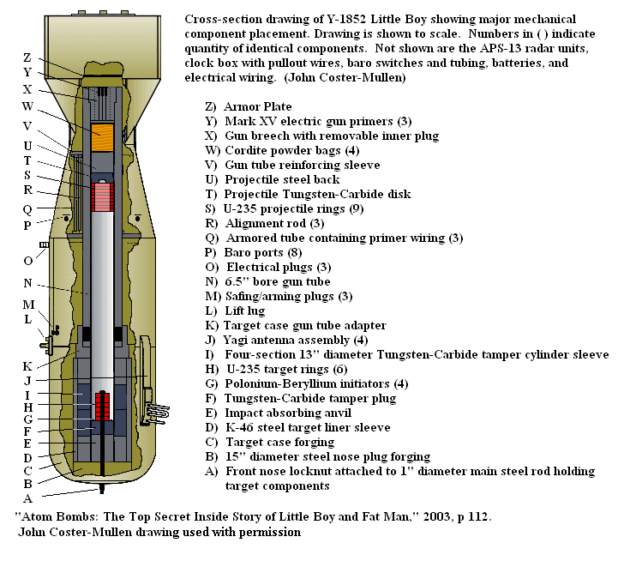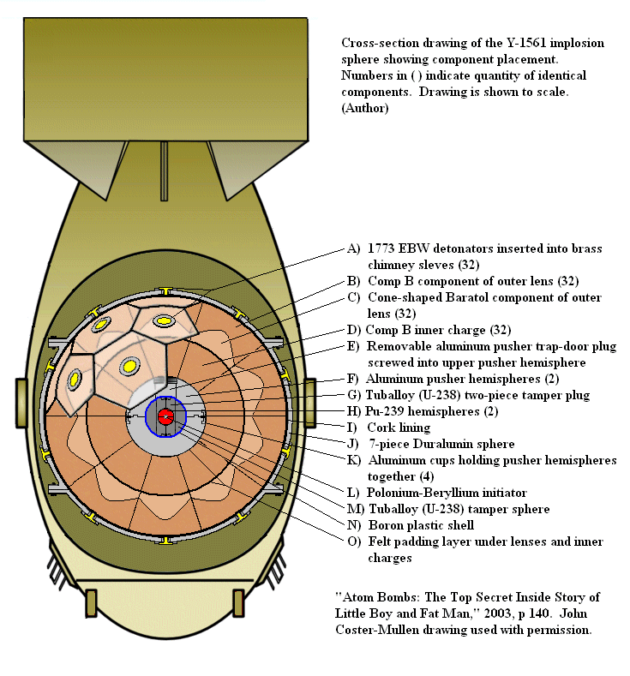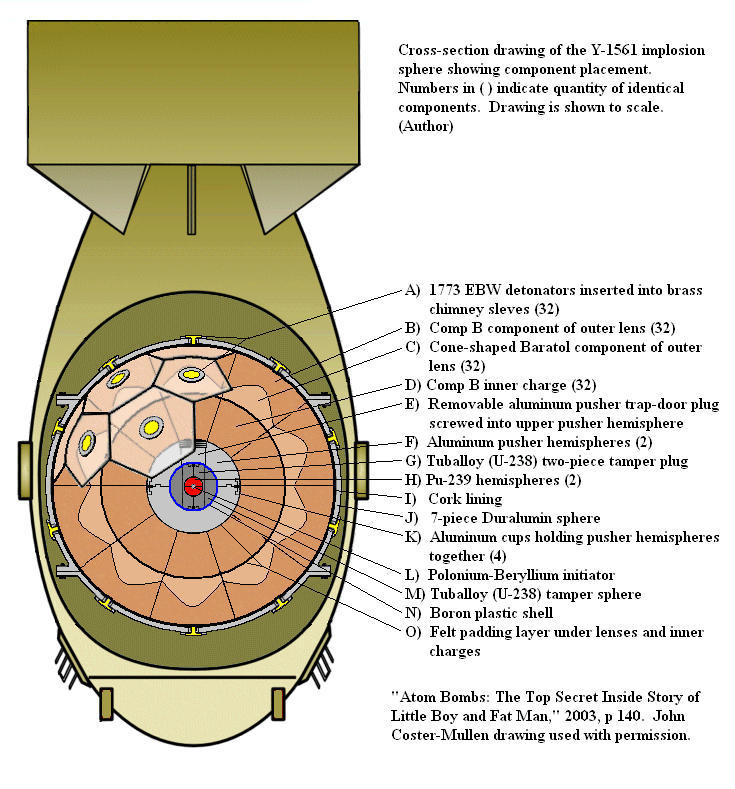Marc Grey
In previous articles, we have covered nuclear reactor designs, accidents and the mechanics of nuclear reaction physics. However, the way the nuclear industry got started was in the manufacture of nuclear weapons, not to provide nuclear power! In this article, we look at how the first nuclear weapons were designed and built.
It is advisable to refer to the physics article as concepts covered in detail there are mentioned with minimal explanation here.
It all started when nuclear fission was discovered in December 1938 by a pair of German chemists. It soon became apparent that there was potential to harness it to produce a weapon. The obvious threat posed by the political situation in 1939 spurred the writing of a letter to the effect that America needed to acquire stockpiles of uranium and accelerate research into nuclear chain reactions.
The British were also researching nuclear fission and in mid-1939 had worked out the critical mass of uranium 235 (25 kg). Britain and America were largely working on their own at this point and it was not until mid-1941 that both countries were aware of each other’s progress. In October 1941 America approved a project to develop an atomic bomb and put the army in charge, headquartered in Manhattan.
Immediately there was the problem of how to separate fissile uranium 235 from the much more common isotope uranium 238. This was hard. The two are chemically identical, so the only workable separation methods made use of the fact that they differed in mass. Three methods were used (electromagnetic, gaseous and thermal), all relying on the higher mass of the 238 isotope to separate it from the 235 one. This was a slow process and by the time the bomb was required, there was only enough high purity uranium 235 for one core assembly!
At about the same time, plutonium had just been discovered, produced from uranium by deuterium capture in a cyclotron:
U238 + H2 ->Pu239
This method produced tiny quantities and was only useful for research purposes, but that was enough to predict that some isotopes should be fissile. At the same time the first nuclear reactors were being built, and this raised the possibility of specific designs producing plutonium in larger quantities via neutron capture and two subsequent beta decays:
U238 + n ->U239 -> (beta) + Np239 -> (beta) + Pu239
Unfortunately, another isotope, Pu240, is also produced by neutron capture of Pu239:
Pu239 + n -> Pu240
This is a highly undesirable impurity as it has a high rate of spontaneous fission. However, despite the impurity, this method turned out to be more efficient at producing weapons-grade material than uranium enrichment.
With two methods for the production of suitable material, the next question was the mechanics of the bombs themselves. This presented some challenges:
- How to construct the bomb in ‘safe’ mode (i.e. not causing a chain reaction), and directly related to this was how to design the placement and distribution of the fissile material, i.e. core geometry.
- How to detonate the bomb (i.e. initiate a supercritical chain reaction) but prevent the core blowing itself apart before it had fissioned all (or most) of its material.
Initial ideas to design a ‘safe’ mode centred around creating two pieces of fissile material, each less than the critical mass, but together more than it. It was also considered that choosing a sub-optimal shape for one of the pieces would enable it to be larger than critical mass, but still subcritical itself.
The idea for detonation was to bring the two pieces together. The design was essentially an artillery barrel with a hollow cylinder ‘bullet’ being shot into a solid cylinder ‘target’ (essentially sliding over it). The ‘cartridge’ was nitrocellulose or cordite conventional explosive. The barrel was made of steel with various more exotic metals (e.g. tungsten) providing containment to allow sufficient amount of core material to fission before explosive breakout occurred. This was referred to as a ‘gun type’ weapon.
However it was discovered that this design could not be used for reactor produced plutonium, as it had enough Pu240 impurities present to likely produce fission while the two parts were still distance apart – resulting in the bomb blowing itself to pieces before much fission had happened!
Fortunately, parallel research had been happening for a much more complex bomb geometry: having a hollow sphere of (slightly less than critical mass) fissile material surrounded by a sphere of conventional explosive charges. These needed to be detonated extremely precisely, so that they would crush the core sphere in a uniform manner, and the explosive shock wave would keep it contained while fission happened. This was an early example of an ‘explosive lens’ technology. The crushing force increased the density of the material so that it would go critical even though it was sub-critical at normal density and pressure. This was referred to as an ‘implosion type’ weapon.
Reliable and efficient detonation was a concern. It was decided to optionally add a neutron source that could be triggered by crushing. This was composed of polonium-210 and beryllium separated by a thin barrier. The polonium, via alpha decay, emitted helium nuclei, which the beryllium could absorb and then emit a neutron via carbon decay:
Po210-> Pb206 + He4 (alpha)
Be9 + He4 -> C13 -> C12 + n
The thin barrier prevented this reaction occurring until the mechanics of detonation crushed the two metals together.
Thus two types of bomb were produced. A gun type using 64 kg of enriched uranium 235; due to the difficulty of making enriched uranium, only one of these bombs was made (so it could not be tested). However, because of the simplicity of its design, the scientists were confident it would work. The relative slimness of the resulting bomb resulted in it being called ‘Little Boy’. The presence of U238 in the enriched U235, coupled with the more-than-twice- critical mass of the core, meant that there was enough likelihood of spontaneous fission from U238 ensuring a detonation, so no neutron trigger was used:

The others were implosion designs using 6.4 kg of plutonium 239 (with small impurities of plutonium 240) made up of two hollow hemispheres. The core was less than critical mass (11 kg), and a neutron trigger was placed in the centre. Three cores were made. The surrounding implosion sphere made the bombs quite plump and so they were called ‘Fat Man’:

The complexity of the design required that a test be conducted. This was a sufficiently big deal that it got its own project name ‘Trinity‘. A 32 metre high structure was built in Alamogordo Bombing Range (now called White Sands). Firstly the implosion mechanism was tested without the plutonium core, and then the entire bomb was assembled and detonated on 05:30 on 16 July 1945. The blast was equivalent to about 25 Kilotons of TNT, The shock wave was felt 160 km away and the resultant crater was 80 metres wide and plated with radioactive glass. The blast cloud reached a height of 11 km!
In the meantime, a means to deliver the bombs presented a challenge – they were too big to fit into either bomb bay of the existing B-29 bombers, so a special project called ‘Silverplate’ was started to modify a number of B-29s by joining the 2 bomb bays together. A fall back plan was to use British Lancasters, but they were not ideal for the task (slower and flew lower, so interception was possible and escape from the blast was more risky).
By 1945 it was clear that finishing the war by doing a conventional land invasion of Japan was going to be extremely difficult, so it was decided to plan for possibly 3 (or more) detonations on Japanese soil. A number of possible sites were selected, including Hiroshima, Kokura, Nagasaki and Kyoto.
On 6 August 1945, a B-29 – the ‘Enola Gay’ – flew towards Hiroshima with the ‘Little Boy’ on board. She was not intercepted, and the bomb detonated at 580 metres with a blast of approximately 15 kilotons of TNT. An area of 12 km2 was destroyed, as were over half the city’s buildings. Some 80,000 people were killed, and about the same number were injured.
When it appeared that Japan was unlikely to surrender, on 9 August 1945, a second B-29 named ‘Bockscar’ departed for Kokura with a ‘Fat Man’ on board. However, cloud cover made sighting difficult so they diverted to Nagasaki. The bomb was dropped over the city’s industrial valley and detonated with a blast of 21 kilotons. The topography of the city meant the larger blast was somewhat confined, so did comparatively less damage (less than half the city buildings destroyed, 28,000 people killed and 60,000 injured).
Preparations to deliver another ‘Fat Man’ were stopped when Japan surrendered on August 15, 1945. To this day it is not clear whether the bombs were a decisive factor or other political events were in fact the cause.
This left the last plutonium core looking for employment. It was repurposed for research where unbelievably reckless scenarios examining ‘near criticality’ were conducted (involving a human operator moving the two hemispheres close to each other without any shielding). Two brief criticality incidents occurred on August 21, 1945, and May 21, 1946. Two scientists were killed via neutron flux exposure, and the core acquired an evil reputation and was aptly named the ‘Demon Core‘.
For a large part of the 20th century after 1945, the exact design details of these bombs remained classified, and even when design depictions were made they were (probably deliberately) wrong. E.g. the use of the polonium neutron source was hidden until the 1960s and ‘Little Boy’ was typically shown shooting a small piece of U235 into a large target mass. This was in fact completely impossible: the complete core mass was 64 kg, over twice critical mass, so the real design used a large cylinder projectile (much bigger than critical mass, but kept subcritical by geometry) and a smaller (subcritical mass) target. It has been remarked that ‘Little Boy’ was in fact a girl…

